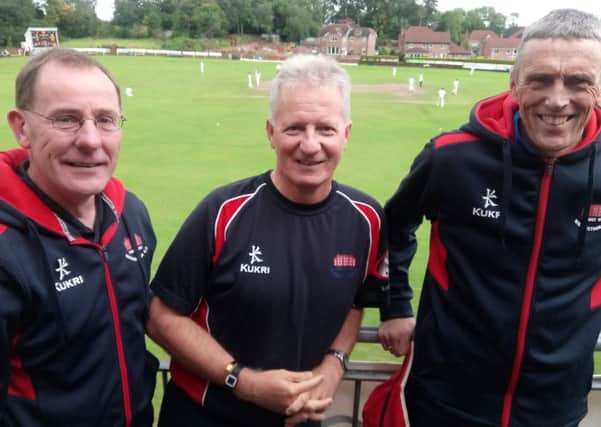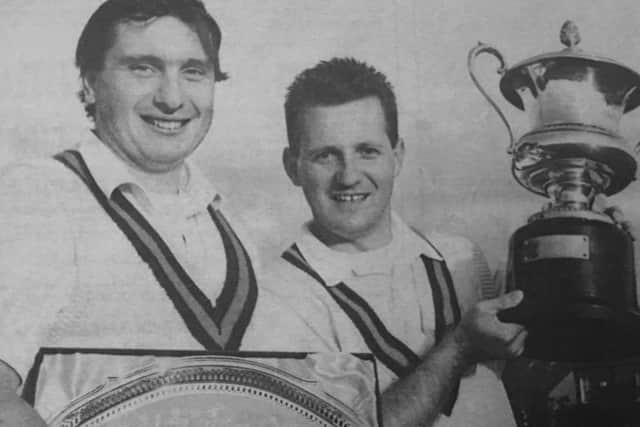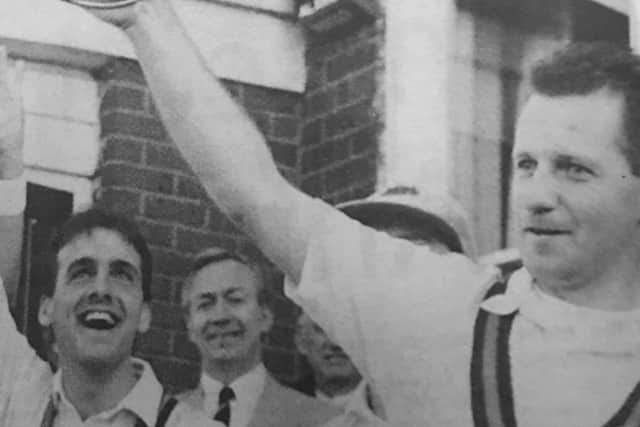Cricket: Story of how Waringstown made history with 1992 treble


Alan Waite, Garfield Harrison and Alan Nelson are soon into their stride, the memories of Waringstown’s historic 1992 campaign flooding back.
It’s 25 years this month since the self-styled ‘Dream Team’ made history by completing the treble of NCU Challenge Cup, Senior League and All-Ireland Cup.
Advertisement
Hide AdAdvertisement
Hide AdHarrison, the captain, was one of the finest Irish cricketers of his generation and the youngest of the famed six Harrison brothers, Waite was a steady batting hand who enjoyed his most prolific season while Nelson was unerringly accurate with the new ball.


Waringstown, who didn’t have a professional, started the road to the treble by beating North in the Challenge Cup final at Downpatrick before defeating Sion Mills in the Irish Cup showpiece at Rathmines.
AB: When did the team start to talk about doing the treble?
AN: I don’t think we actually spoke about the treble until we got two in the bag. The fixtures were piling up and some people might have thought we were going to come unstuck at some stage, but we didn’t, we just kept churning out the wins.
AB: What individual games stick out in your minds?


GH: One day going down to Bangor, it was a flat deck, and they bowled us out for 85, we had a real bad day. And you were thinking, we are going to have to pull something out of the bag and we did, we bowled them out for about 40. It was Paul McCrum and big Nelly (Alan Nelson) who did the damage. There were games that we played badly in but still won. We had that much depth in the side, people say that our batting was good, but our bowling was exceptional.
Advertisement
Hide AdAdvertisement
Hide AdAW: We had a bowling attack that complemented each other, you had Alan who was on the spot all the time, you had Noel (Nelson) who swung the ball, you had Spencer (Alvin Spence) who made it bounce, and with (Paul) McCrum he came out and blasted the opposition away, Bangor got about 30 and Ballymena 50 or 60. As far as he was concerned, the two of them, him and Nelly, they were never beaten. They said to themselves, “We only got 80, the opposition are going to get less”.
AN: Other teams gave us so much respect, when you nailed one or two early on you caused teams to crumble because you seemed to have an aura over them. That Bangor game in particular, they were 10 for three chasing 90 and they seemed to say to themselves, “we are not going to get that against these guys”. We seemed to have a stamp on everyone.
GH: Our opening bowling attack was Alan and Paul McCrum, first change was Noel and Alvin Spence, that was the Ireland bowling attack at that time more or less, and then you had Ivan Anderson, who was in the twilight of his career but still knew what he was doing with the ball, and myself, and Shane (Harrison).


AN: Simon O’Neill was a good wicket-keeper, a very under-rated keeper, and he stood up to the seamers. It would be interesting to see how many he stumped off the seamers that year.
Advertisement
Hide AdAdvertisement
Hide AdGH: Anything that they edged he caught it, he dropped very, very few.
AB: Ivan Anderson was nearing the end of his career but he played a major role?
AN: There was a man in that team who kept everyone’s feet on the ground, a man with a beard in his fifties, it was his last season, and he was valuable to have bowling a few overs and batting at nine and telling you off. He was a handy addition.


AB: What stood out for me as a 15-year-old boy looking on was how completely focused you all looked.
Advertisement
Hide AdAdvertisement
Hide AdGH: We only used about 14 players that season, everyone was fully committed, was available for every game, you weren’t having to chop and change every week, it was the same team. We all sort of realised after a while that we had something going here, and everyone fully committed to it.
AB: The first of the three trophies was the Challenge Cup. Shane Harrison set it up with a big first-innings hundred, how good was it?
GH: It was a good hundred, I remember going into bat that day, and Simon Redpath was bowling at one end and Growler (Simon Corlett) at the other. Redpath was quick that day and it took me four or five overs to get adjusted to the pace and Shane was standing at the other end just smacking it round all over the place. It was a really good hundred and it turned into a comfortable win after we took a big first-innings lead.
AW: North had given us a couple of absolute hidings in a couple of semi-finals, I remember Mark Napier smashed us all over the place. North-Waringstown games then were always highly competitive, and they were played in the best of spirits.
Advertisement
Hide AdAdvertisement
Hide AdAB: Waringstown had that long, unbeaten record in cup finals at Downpatrick. Do you think that intimidated the opposition?
AN: I felt we would not get pipped very often over two innings, even if we didn’t played that well in one, certainly it wouldn’t happen twice. I don’t remember it happening twice in all those finals.
AW: You would be lying if you said you weren’t aware of it. By that stage the record that Waringstown had built up over so many years, there was that bit of added pressure going into those finals, we had never lost at Downpatrick, it was always there in the back of your mind. There were a couple of finals, the Lurgan one in ’87 when Ross (McCollum) and Subash (Kshirasgar) had the match won, and we turned it around, and then in ’86 Spencer hit the runs. It was always in the back of your mind, we could be the first Waringstown team to lose a final.
AB: Before you won the league, you had the Irish Cup final against Sion Mills, who had beaten Donemana in the final. What kind of a game was it?
Advertisement
Hide AdAdvertisement
Hide AdGH: The All-Ireland final was at Rathmines, they were a good bowling and fielding side, Bobby Rao had them playing very well at that time. We batted first and got 171, it was a hard-fought 171, it wasn’t easy. We knew at half-time we had our work cut out. Sion were then 50-0 after 10 but we had that never-say-die attitude, the big turning point for me was a catch from Shane. He was out on the boundary, he had to run in, dived full-length and left-handed and caught it six inches off the ground. Bobby Rao was out next ball to Brian Sturgeon, it just typified the team, guys would have run through a brick wall for you. We ended up wining by 40-50 runs, There was so much fight in the team, and that day was Sturgy’s. He did bowl very well and he wasn’t a regular bowler.
AB: When you got the league wrapped up and the treble was secure, what was the sense of accomplishment? Were you the best Waringstown team ever?
GH: It took a while for the enormity of it to sink in, it’s only ever been done by a couple of teams, no-one had ever done it before in the NCU or since. It took a huge effort, but the celebrations were good. A couple of nights in the Planters were interesting.
AW: It was the high point, for that year it was absolute commitment, Waringstown have been successful this year on the back of 13-14 players, if you can get that consistency, you can get quality players all playing together. Remember we had no pro. This was all local guys playing probably at the peak of their powers.
Advertisement
Hide AdAdvertisement
Hide AdGH: Everyone else had a pro, we were the only club that didn’t have a pro and we didn’t need one, we had that much talent at our disposal. It was a very special side and everyone made a contribution. Alan Waite had 900 runs batting at number three. That was a big help to the batting order. It wasn’t the most difficult team to captain for me.
AW: It makes for good banter, as far as we were concerned, we were the best and we keep getting better as the years go past! It’s good banter debating it with today’s team, but it’s increasingly difficult to compare eras.